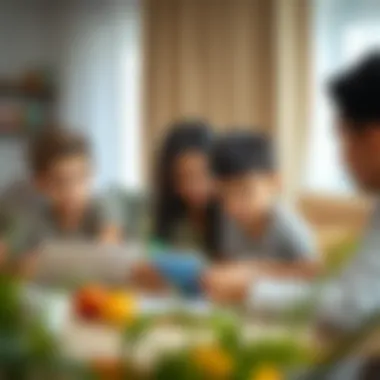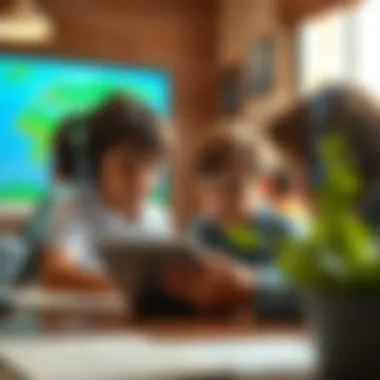School Closures in the UAE: Key Considerations and Insights


Intro
Navigating the landscape of school closures in the United Arab Emirates (UAE) can feel like riding a camel through the shifting sands of time—one moment you're on solid ground, the next, the environment shifts unpredictably. With a unique blend of cultural influences, diverse educational frameworks, and dynamic regional policies, understanding how school closures affect families and students is crucial.
In recent years, various factors have come into play, shaping not only the school calendar but also the lives of parents, educators, and students alike. This article aims to unpack these complexities by providing an in-depth exploration of the key elements that influence school closures and their implications in the UAE.
Parents often find themselves juggling work obligations while seeking effective alternatives for their children’s education during these closures. Cultural and social norms further complicate the situation. For instance, religious holidays and traditional festivities may necessitate flexible schooling options that aren't always clearly communicated.
The need for a comprehensive understanding of this topic is underscored by its relevance across multiple sectors—whether you're a parent navigating these waters, an educator adjusting lesson plans, or a stakeholder invested in the educational landscape of the UAE. In the sections that follow, we will delve into the various elements impacting school closures, offer practical advice on how to navigate these challenges, and shine a light on the regional disparities that affect educational continuity.
Understanding the Academic Calendar
In the dynamically evolving education landscape of the UAE, understanding the academic calendar is vital not just for students and parents but also for investors, real estate agents, and other stakeholders in the community. The academic calendar serves as the backbone of the whole educational system, offering a roadmap that delineates when the new school year begins, the duration of breaks, and any significant holidays.
This framework has significant ramifications for the overall planning and scheduling of educational, social, and even economic activities across the country. When school closures occur, they can ripple through various sectors, demanding adaptive strategies to manage the resulting impacts on both educational progress and family routines. Thus, grasping the structure of the academic calendar becomes imperative for all parties involved.
Overview of the School Year
The school year in the UAE typically spans from September to June, with various academic institutions, especially private schools, tailoring their specific start and end dates according to their individual curricula. The Ministry of Education oversees the official framework, aiming to create consistency across public schools while allowing some room for flexibility among private institutions. In this regard, understanding how the school year is segmented—into terms and semesters—equips parents and stakeholders to better prepare for academic and non-academic demands.
Generally, the school year includes two main semesters, each punctuated by term breaks. This cyclical approach ensures that students have the opportunity to recharge and regroup, benefitting their academic focus and mental health. Parents, recognizing these patterns, can better coordinate family schedules, vacations, and other plans that hinge on these academic timeframes.
Official Holidays and Breaks
Official holidays and breaks are woven into the academic calendar, serving not only as much-needed respites for learners but also as cultural observances for the wider community. For example, holidays like Eid Al Fitr and Eid Al Adha, determined by the lunar calendar, shift yearly, creating a variable element in planning. Education authorities typically announce these holidays early, allowing families to adapt their plans accordingly.
Other breaks, such as the winter holidays and mid-term breaks, are standardized across many schools, providing a measure of predictability. Recognizing when these holidays occur assists families in organizing travel or familial gatherings, but it also presents real estate and economic considerations for businesses catering to families with school-aged children.
Regional Variations in School Schedules
The UAE is a melting pot of cultures, and this diversity extends to regional variations in school schedules. Public schools usually follow a nationally recognized calendar, but due to the high volume of expatriates, private schools often adopt curricula from their home countries—be it British, American, or others. Each of these systems introduces distinct academic calendars, often translating to different holiday schedules and term lengths.
For instance, a British curriculum school might align its school year with the UK’s, resulting in breaks that might not coincide with Islamic holidays. Understanding these nuances allows parents and stakeholders to navigate educational environments effectively, fostering an environment resilient to the challenges that school closures bring.
"Knowledge of the academic calendar is not merely insightful; it is a necessary toolkit for thriving within the multifaceted UAE educational landscape."
In summary, the academic calendar forms a critical framework that informs various aspects of school life and community engagement. By being well-acquainted with its structure, stakeholders can make informed decisions that enhance educational experiences while addressing the broader societal implications.
Factors Influencing School Closures
School closures are multifaceted events shaped by various influences. In the context of the UAE, three significant factors can dictate the decision to temporarily halt educational activities: government regulations, public health safety, and adverse weather conditions. Understanding these elements is crucial not just for educators but for parents, students, and the wider community, given the profound impacts these closures can have on academic continuity and overall well-being.
Government Regulations and Guidelines
Government regulations play a pivotal role in determining school closures. These directives stem from both local and federal authorities, considering factors like health safety and educational stability. During the COVID-19 pandemic, for instance, the UAE's Ministry of Education provided clear guidelines on when and how to close schools. They aimed to ensure the collective safety of students and staff, taking into consideration both the immediate and long-term effects on education. These regulations are often issued in conjunction with health advisories to maximize community safety.


Factors influencing such regulations include:
- Epidemiological Data: This involves assessing the spread of diseases and the impact on public health. Data from health organizations and hospitals are essential in making informed decisions.
- National Policies: The UAE’s strategic approach to education reforms impacts closures. The government regularly reviews and updates policies based on emerging trends, ensuring schools can adapt efficiently.
- Consultative Processes: Engagement with educational bodies and stakeholders helps formulate best practices regarding closures, often addressing the concerns of parents and teachers alike.
Public Health and Safety Concerns
Public health concerns remain at the forefront of decisions regarding school closure. In times of crises, such as viral outbreaks or environmental hazards, schools must prioritize the health of students and staff. For example, the outbreak of contagious diseases often leads to brief closures to allow time for ascertaining safety protocols, ultimately curbing the spread within the community.
When schools are dismissed in light of health concerns, several dynamics come into play:
- Hygiene and Sanitization: Ensuring a clean environment upon reopening becomes a priority. This often entails substantial investment in disinfecting facilities before conducting classes again.
- Mental Well-being: The emotional toll on students during unexpected closures is noteworthy. Authorities are therefore called to ensure mental health resources are available remotely or through community outreach programs.
- Community Engagement: Keeping parents informed and engaged during such times is paramount. Learning how other families navigate similar challenges reinforces community bonds.
Weather-Related Closures
Weather conditions also have a marked impact on the school calendar in the UAE. Although the country is known for its annual sun-soaked skies, there are instances of extreme weather—particularly during the summer, when temperatures soar, or unexpected storms arise during winter months. Each year brings its peculiarities, which necessitate swift responses from educational institutions.
Specific factors to consider include:
- Heat Waves: Extreme temperatures can render outdoor activities unsafe, prompting schools to modify schedules or even shut down for the day.
- Sandstorms: Given the geographical elements, sandstorms can disrupt visibility and air quality, making attendance hazardous.
- Emergency Preparedness: Schools must devise clear protocols when meteorological reports signal trouble, ensuring the safety of all individuals on campus.
"Awareness of the underlying factors guiding decisions allows for proactive responses during closures, benefiting students and families alike."
For more information, you might consider visiting government health advisories or educational resources at www.moe.gov.ae or www.who.int.
Implications of School Closures
The topic of school closures doesn’t merely skim the surface of logistics regarding academic calendars; it plummets deeper into the very core of educational integrity and student welfare. In the United Arab Emirates, where education forms a fundamental bedrock of societal advancement, understanding the implications of school closures is not just important, it’s crucial. It affects not only students but also parents, educators, and the community as a whole.
When school doors shut, numerous ripples disrupt the educational ecosystem. Students’ academic progress, mental health, and social skills are just the starting point of this cascade.
Impact on Academic Progress
Academic progress stands at the heart of educational endeavors. It involves not only curricular achievements but also personal development milestones. In the UAE, school closures often lead to disrupted learning routines that can hinder the educational trajectory of students.
Students miss classes, exams can get postponed, and teachers struggle to maintain engagement through virtual formats. This situation can often create gaps in knowledge. A student might understand biological processes but fall behind in mathematical concepts because those lessons were never received due to cancellation of classes.
Moreover, assessments initially planned may need modification or adjustments, leading to a lack of standardization across different institutions. The learning protocols established by local educational authorities often cope with these changes but vary widely, further complicating the educational landscape.
"In times of uncertainty, the challenge lies in ensuring academic continuity and resilience."
As students grapple with changes, the added anxiety about their academic futures can result in lower morale and disengagement. Ensuring that students have clear channels for continual learning, such as engaging apps or supplemental resources, becomes essential.
Mental and Social Well-being of Students
School is not just a place for academic learning; it is also where children develop crucial social skills and emotional stability. The Covid-19 pandemic has highlighted how mental health can suffer when schools close. For young learners, their world shrinks without daily interactions with peers and educators. Isolation can quickly set in, leading to feelings of loneliness and anxiety.
Parents may notice changes in behavior and mood as kids navigate the absence of their usual routines. This lack of social interaction can stunt emotional growth and hinder the development of interpersonal skills that are typically sharpened during classroom interactions or extracurricular activities.


Moreover, it’s important to recognize the role of educators in providing a stable emotional environment. With closures, teachers often become distant figures. Addressing mental health needs while schools are closed becomes of utmost importance, with strategies such as maintaining virtual check-ins, providing resources for mental health support, and encouraging open conversations about feelings.
Parental Challenges During Closures
For parents, the closure of schools presents a myriad of challenges. Many find themselves in a tight spot, trying to juggle work from home or even working outside, while also stepping into the role of educators. The transition to homeschooling can be daunting, often requiring financial resources for materials or subscriptions to online learning platforms.
Additionally, not all parents are trained educators, which can lead to frustration for both parties involved. It can feel like a serious uphill battle when trying to keep children focused and engaged, the classic struggle becomes teaching rather than just parenting—blurred lines that can strain relationships.
Compounding this is the reality that parents must also worry about their children’s emotional needs during these times. Communications with schools can be challenging, as impacted parents might feel sidelined, without adequate support and guidance.
Understanding these implications can assist stakeholders in the educational sphere—whether it be parents trying to maintain stability at home or educational authorities tweaking their operational strategies. Every move made during these periods has the potential to either bridge the gap or widen it. Examining these implications not only highlights the challenges but also provides a foundation for creating informed solutions.
Navigating School Closure Periods
When schools in the UAE close their doors, it can create a whirlwind of uncertainty for families, educators, and students alike. Understanding how to navigate these periods isn't just about keeping educational momentum; it’s also a crucial step towards maintaining mental well-being and social engagement during times of disruption. As we delve into this section, we’ll explore effective strategies that can help families tackle these challenges head-on.
Tips for Maintaining Learning at Home
Home learning can feel like a double-edged sword. On one hand, it offers flexibility and a chance to cater lessons to a child's unique learning style. On the other, it can present hurdles that traditional schooling simply doesn’t. Some strategies to preserve the educational flow while at home include:
- Establishing a Routine: Kids thrive on predictability. Set specific times for learning, breaks, and play. A consistent schedule can mimic the school environment and help students stay focused.
- Creating a Dedicated Learning Space: Designate an area in the home for educational activities. This separate space can signal to children that it’s time for serious learning.
- Incorporating Interactive Learning: Use hands-on activities to teach difficult concepts. Science experiments using household items or art projects can keep engagement high alongside core subjects.
- Utilizing Study Time Wisely: Encourage the use of various resources, such as workbooks, online exercises, or educational apps. Aim for a balance between traditional learning and tech-savvy methods.
Engaging with Online Learning Resources
The digital age has opened a treasure trove of learning resources at our fingertips. Navigating this world effectively can enhance a child’s learning experience significantly. Here are several approaches to consider:
- E-Learning Platforms: Websites like Khan Academy and Coursera offer excellent free courses. Tailor these to your child’s grade level and interests to spark their excitement.
- Virtual Tutoring: In times of closures, many educators are transitioning to online settings. Having a one-on-one tutor can personalize the learning experience and address specific challenges a student may face.
- Online Libraries and eBooks: Resources such as Project Gutenberg or the National Digital Library can provide access to a variety of texts suited for various age groups, enabling a more self-directed approach to reading.
- Interactive Games and Quizzes: Engaging tools like Kahoot or Quizlet turn learning into a fun and competitive activity, which can often keep kids eager to learn more.
Activities to Support Social Interaction
Social interaction is essential for a child's emotional health and growth. While school closures might limit face-to-face interactions, alternatives can keep those connections strong. Here are some ideas:
- Virtual Playdates: Arranging online sessions where kids can interact through games or casual chats can keep friendships alive. Platforms such as Zoom or Google Meet are great for this.
- Community Projects: Encourage kids to partake in home-based community service projects. Whether it’s creating care packages or virtual fundraisers, these activities foster a sense of community and connection.
- Group Challenges: Organize group challenges like book clubs or scavenger hunts via social media or messaging apps. This fosters teamwork, creates shared experiences, and maintains peer relationships.
- Family Game Nights: Regularly scheduled game nights can not only enhance social skills but also strengthen family bonds. Whether it’s board games or online multiplayer games, these gatherings are a means of ensuring kids aren’t feeling isolated.
Navigating school closure periods requires a balanced approach, merging learning with interaction, and maintaining structure while offering flexibility. By implementing these strategies, families can make the most of the time spent at home, ensuring that education remains a priority while investing in well-being and connections.
Parental Guidance and Communication
Effective communication between parents and schools is the backbone of a child's educational journey, particularly during school closures. When the landscape of education shifts due to unforeseen circumstances, such as a pandemic or natural disaster, parents become the cornerstone in ensuring their children remain informed and engaged.
Effective Communication with Schools
Clear and consistent communication is not just a convenience; it's a necessity. Parents must establish a routine for staying informed about school policies, schedule changes, or any guidelines issued by the educational authorities in the UAE. One useful strategy is to set up a dedicated channel for updates, which could be based on official school newsletters, email alerts, or even school apps.
- Stay Proactive: By regularly checking in with various communication outlets, parents can anticipate changes before they are impacted. This proactive approach minimizes confusion and helps parents plan accordingly.
- Leverage Technology: Many schools now use platforms that facilitate direct communication between teachers and parents. For instance, using tools like ClassDojo or Edmodo can enable parents to stay on top of assignments and announcements, which is crucial during closures.
- Attend Virtual Meetings: Participating in online meetings or webinars hosted by schools or educational authorities can provide parents with valuable insights on methods to support their children's learning from home.


"Open lines of communication can foster a collaborative environment where both parents and educators work hand in hand for the child's benefit, especially during trying times."
Addressing Concerns During Unforeseen Closures
Unforeseen school closures can stir up a myriad of concerns among parents. It's natural to feel overwhelmed, but addressing these worries with clarity often leads to practical solutions.
- Acknowledge Emotions: Parents should feel free to express their concerns with teachers or school administrators. Whether it's about academic progress or social anxiety their children might experience due to interrupted learning, sharing these feelings can provide relief and promote constructive discussions.
- Understand Grading Policies: Clarity around how grades will be impacted during closures is essential. Understanding any modifications to testing, assignments, or overall evaluation can help parents guide their children through these times.
- Promote Open Dialogue with Children: Parents should encourage their kids to talk about their experiences and feelings while schools are closed. This not only helps children articulate their sentiments, but also allows parents to better understand their needs and adapt their support accordingly.
Future Trends in Education within the UAE
Education in the UAE is undergoing a transformative phase. The recent events surrounding school closures have catalyzed an evolving landscape, igniting discussions about the future of learning models in the region. As we look ahead, several elements emerge as important considerations that could benefit students, educators, and even investors involved in the educational sector.
Adapting to Hybrid Learning Models
Hybrid learning has surfaced as a viable solution blending traditional in-class education with online components. Schools have had to pivot, quickly integrating technology into their curriculum, creating an environment that supports both face-to-face and digital learning. This dual approach offers flexibility, allowing students to learn at their own pace while benefiting from direct interaction with educators.
Adopting hybrid models holds several advantages:
- Flexibility in Learning: Students have greater autonomy over their learning schedules. Those who might struggle in a conventional classroom setting can thrive in a hybrid environment.
- Accessibility: This model can bridge the gap for students residing in remote areas of the UAE, enabling access to quality education through online platforms.
- Resource Efficiency: Schools can optimize resources by shifting some classes online, allowing for smaller classroom sizes when in-person sessions occur.
However, as appealing as they are, hybrid models are not without challenges. There must be a strong infrastructure in place, including reliable internet access and training for educators to deliver effective online content. Parents, too, must be engaged in this learning journey, fostering an environment conducive to participation and growth.
Technological Innovations Shaping Education
Technology is more than just a tool for hybrid models; it’s a game-changer in the educational field. The rise of artificial intelligence, virtual reality, and big data analytics is altering how educational institutions structure their curricula and improve student outcomes. This adoption of technology isn't merely a trend but a critical evolution that influences every aspect of learning.
Key innovations include:
- Personalized Learning Experiences: AI can analyze students' progress and tailor the curriculum according to individual needs, making education more relevant and effective.
- Simulation and VR Tools: These technologies can create immersive learning experiences, especially in practical subjects like science and engineering, enhancing understanding through experiential learning.
- Data-Driven Insights: Utilizing analytics helps educators understand learning patterns and performance trends. This data can inform instructional strategies and identify students who may need additional support.
The forward momentum of tech adoption within education promises exciting opportunities, but it’s essential to approach this seamlessly. The integration of new technologies must consider user experience to ensure that both students and educators can adapt comfortably.
"In an era where technology interweaves with daily life, our educational systems must evolve, embracing modernization while remaining anchored in foundational learning principles."
As we see these trends unfold across the UAE, it is evident that stakeholders — including investors and real estate developers — will want to stay attuned to these developments. The changing educational landscape offers both challenges and opportunities, paving the way for a nuanced and enriched learning environment suitable for the 21st century.
Closure
As the discussion surrounding school closures in the UAE wraps up, it’s clear that the topic holds significant weight across various domains. Understanding the dynamics of school closures not only equips parents and educators with the necessary tools for survival during such times but also enhances the educational landscape overall. These closures invite scrutiny and drive adaptation—benefitting students, families, and respective institutions in the long run.
Summary of Key Insights
In summary, the key insights from this exploration include:
- The Academic Calendar: The school year in the UAE is marked by a well-structured calendar which outlines holidays and breaks, ensuring that students have quality time both in and out of the classroom.
- Influencing Factors: Various elements, such as government regulations, health concerns, and environmental factors, play into when and why schools may close. Each of these influences shapes the decisions made by school administrators and policymakers.
- Implications on Students: School closures affect more than just academic progress; they ripple through mental health and socialization opportunities for students. Awareness of these implications is vital for effective response.
- Navigational Strategies: Effective guidance for parents—through communication and resource utilization—proves beneficial for maintaining educational continuity during closures. Engaging with online platforms and maintaining social interactions can provide students with crucial support.
Looking Ahead
Looking forward, the landscape of education in the UAE is poised for change. With potential shifts towards hybrid learning models and increasing technological integration, we may see a move towards a more resilient educational framework. The lessons learned during recent closures could prompt educational reforms, allowing schools to adapt swiftly to future disruptions. Embracing innovation is key; it’s not just about thinking outside the box, but also about redefining what the box looks like in the first place.
"Education is the most powerful weapon which you can use to change the world."
– Nelson Mandela
As schools look towards the future, stakeholders in UAE's educational system—parents, teachers, and policymakers alike—will need to stay informed and agile. The ability to navigate these changes effectively will be fundamental to fostering an environment where every child can flourish, no matter the circumstances.















